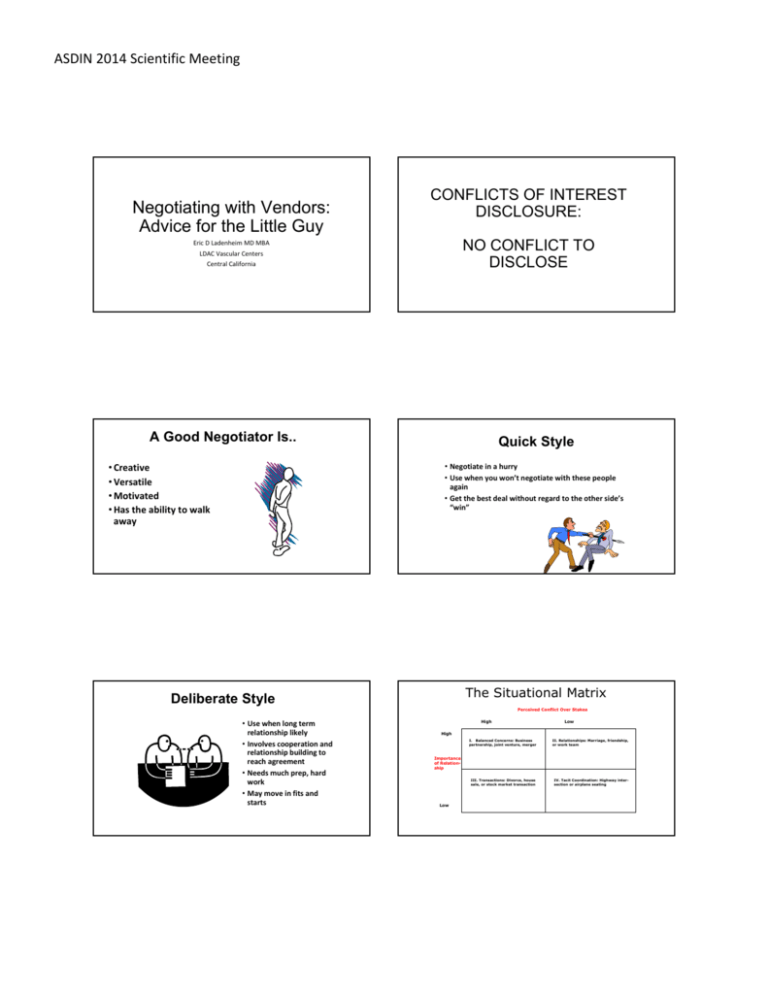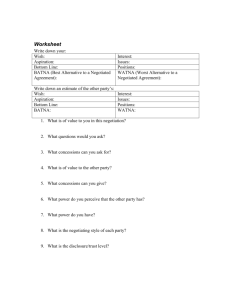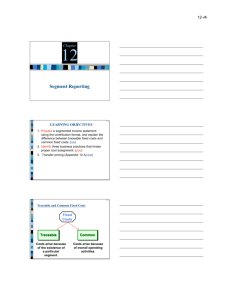Negotiating with Vendors: Advice for the Little Guy
advertisement

ASDIN 2014 Scientific Meeting Negotiating with Vendors: Advice for the Little Guy CONFLICTS OF INTEREST DISCLOSURE: NO CONFLICT TO DISCLOSE Eric D Ladenheim MD MBA LDAC Vascular Centers Central California A Good Negotiator Is.. Quick Style • Negotiate in a hurry • Use when you won’t negotiate with these people again • Get the best deal without regard to the other side’s “win” • Creative • Versatile • Motivated • Has the ability to walk away The Situational Matrix Deliberate Style Perceived Conflict Over Stakes • Use when long term relationship likely • Involves cooperation and relationship building to reach agreement • Needs much prep, hard work • May move in fits and starts High Low High I. Balanced Concerns: Business partnership, joint venture, merger II. Relationships: Marriage, friendship, or work team III. Transactions: Divorce, house sale, or stock market transaction IV. Tacit Coordination: Highway intersection or airplane seating Importance of Relationship Low ASDIN 2014 Scientific Meeting Negotiating • Tacit Coordination - Calls for tactful avoidance of conflict, not negotiation. • Transactions – Stakes, such as price, are substantially more important than relationships. Leverage counts. • Relationships - Treat the other party well, generously, the stakes are secondary. Accommodate. • Balanced Concerns - Problem solving and compromise are vital. Stakes and relationships equally important. Preparation 3. 4. Identify other side’s interests, needs, and objectives. Determine your targets. – – – – – Specific opportunity/product/event Price Size of order Share of budget Terms and conditions Why use a GPO? • Cath Labs choose to use a GPO because the GPO has demonstrated value. • Better pricing than what the Cath lab can get on it’s own • Informatics that assist with product standardization, pricing control and benchmarking. • Flexibility with regional contracting. Preparation 2. Assess negotiating styles. – Competitors – Cooperators • Match the other side’s style. • • If you’re a cooperator, a competitor will eat your lunch. If you’re a competitor, you will tend to gouge a cooperator. Preparation 5. 6. 7. Determine your BATNA (Best Alternative to a Negotiated Agreement). Determine your HLE (Highest Legitimate Expectation). Determine your walk-aways. – Price – Terms and conditions How Important are GPO’s? • Hospitals (on average) make 72% of their purchases through GPO contracts • Access Centers much less LDAC Purchases 10% of supply costs from GPO’s ($158,000 out of $1.6 million) • Cath Labs don’t have the staff to negotiate with thousands of vendors. They will negotiate large spend areas, capital, or minor equipment contracts on their own or in conjunction with their GPO. • Some GPO’s demonstrate value in other areas. 1. Healthcare Supply Chain Association 2013 estimate ASDIN 2014 Scientific Meeting Alternative Outcomes to Reaching a Negotiated Agreement BATNA WATNA Best Alternative to a Negotiated Agreement Worst Alternative to a Negotiated Agreement BATNA The least damaging outcome anticipated if no agreement is reach. If you have an alternative Negotiated contract then this is your best fall back option If you don’t have an alternative Negotiated contract then your Best alternative is the GPO price What is a GPO? Helps negotiate discounts with manufacturers, distributors, and other entities WATNA The most damaging outcome to anticipate if no agreement is reached. List Price is most damaging outcome if no agreement is reached BATNA Advantages • Forces negotiators to realistically evaluate their negotiating strength • Prevents blind negotiations • Protects from accepting terms that are too unfavorable WATNA Advantages • Forces negotiators to realistically evaluate their options • Prevents power negotiations • Protects from rejecting terms that are in your interest to accept ASDIN 2014 Scientific Meeting Signaling Leverage Your Leverage as You See It Strong Weak Firm How You Want to Act Flexible Make confident demands and credible threats. Emphasize the uncertain future. Display your alternatives and leave the decision to the other Side – “take it or leave it.” Bluff (act strong when you are not). Show (and tell) the other side you’re investing in the relationship. Acknowledge the other side’s power and stress the potential gains from future cooperation. Be generous. Appeal to the other side’s sympathy. What would they say in your position? Opening and Making Concessions • Bargaining formally begins when one side opens with a concrete, plausible (in their mind) offer. • Don’t respond emotionally to any offer or any tactic. • Getting emotionally involved leads to awful decisions Opening Tactics: Open First? Concession Tactics • If you are not informed about the other side’s business, interests, or demands, don’t open first. • If you are well informed, open first: • Open optimistically and have room to make concessions. • Concessions are the language of cooperation. They tell the other side in concrete, believable terms that you accept the legitimacy of their demands and recognize the necessity to cooperate and sacrifice to get a fair deal. • It lets you fix the range, the zone of realistic expectations. • Sometimes forces the other side to rethink its goals. • Most important, allows you to set the anchor. • We tend to be heavily influenced by first impressions. Concession Tactics • To get movement, offer a small trade -show that agreement is possible. • Give a trade or concession in your least important area -- price to get a desired deal term or payment, e.g. • The other side’s first concession is in its least important area of concerns. • Try not to give the first major concession (it raises expectations and confuses people). • Put the major issues aside, agree on small, easy issues first. Concession Tactics • Give small concessions and give them slowly. • The slower you give them, the more value they have. • A fast concession makes the buyer feel awful (“Could’ve gotten more”) and devalues the product. • Make them work hard for every concession, they will appreciate it more. • Make concessions progressively smaller. ASDIN 2014 Scientific Meeting Split the Difference? Closing Tactics • Not unless it’s in your favor. • Split the difference? • If the other side offers it, it usually isn’t. • Split the split. • The most likely settlement point in a negotiation is the midpoint between two opening offers. • People who prefer a cooperative style like to cut through the bargaining process and often offer to split the difference at the beginning. • When the relationship is important, split the difference; it’s a smooth way to close. • In a transaction situation, the midpoint may be too much in the other side’s favor; don’t split. • In a balanced concerns situation; problem solve – widen the options -- before splitting. Buyers’ Tactics Buyers’ Tactics • The Big Bait (Search for rock bottom) • Deliver Garbage (Lowers expectations and confidence) • Good Guy/Bad Guy (Forces the wrong comparison) • The Flinch (Brings out guilt feelings) • The Price Tag (Sets a limit) • Red Herring (Manufactures an issue, tries to transfer concessions) • The Crunch (Implies they’re hot, but won’t give a number) • Silence (Tries to get the other side to respond with concessions) • Cherry Pick • Auction Buyers’ Tactics • Blackmail (Never give in to threats, makes you vulnerable in the future) • Change of Pace (Brings you close, then backs off to get you frustrated and to conceed) • Escalation (Takes back a concession) • Split the Difference (After a low offer) Purchasing Axioms • A Firm Has The Suppliers It Deserves • A Supplier Will Only Be As Good As It Has To Be • The Best Way To Get More From Suppliers Is To Ask For It ASDIN 2014 Scientific Meeting Your Performance is Being Measured Us De 9 Forecast Accurately 9 Share Information 9 Minimize Rush Orders and Schedule Changes 9 Focus on Total Cost ‐ Not Price 9 Pay Bills On Time 9 Manage Supplier Relationships 9 Contractual Protection and Liabilities 9 Supplier Management/Performance 9 Other Important Criteria sig 2.Cost Benchmarking 3.Negotiation Frequency f l ow co t os r c fo n 1.Should‐cost modeling Di sc e o st ge os nt p Op tim izi ng E ay m Sh ou ld ‐c os en t m tia c xc hm od tio ha el n ar ng en fr in k e t t g eq in Ra g er u en te m s cy Ne go Co st b s te ba Cost Management Methodologies Benefit What is it? Methods What it is? An analytical technique to estimate suppliers’ cost of goods/services, which is to use in negotiations and with internal customers / stakeholders Use as a basis in driving cost reduction at pricing negotiation & managing cost to achieve cost saving 6.Optimizing Exchange Rate A process that systematically gather data on other companies’ cost & strategies via surveys, &/or telecons to identify relative position & opportunities for improvement To identify relative cost position and industry best practices showing the most potential to save $, use them to achieve BIC pricing and practice 7.Meets Comp Pricing The interval of price re‐negotiations, determined by assessing factors, i.e. market conditions, internal customer, cost requirements, # of suppliers… ou E) * ion g* ng n NT in ing iat te io ici g ( ric ot ric at da Pr cin eg p P lid ty i er u p r N m so m ivi t hr P o t n t o e d c t C o s rn ss fe ee C ts te Ef Pa Cu xc ee ain In ed M o E Ch or t t er av No pli t F p s o Su M Re Cost Management Methodologies Methods When It Comes to Cost Management, Every Technique Counts Systemically conduct frequent i.e. quarterly pricing negotiations proved to deliver better cost reduction results vs. those negotiate less 4.Supplier Chain Consolidation A process to reduce total # of suppliers thru. qualifying & contracting w. integrated/global strategic suppliers to consolidate supply chain Reduce a company’s overall supplier chain management spends by “5%‐15% or more” over time & help to focus on the areas of greatest opp.* (*McKinsey & Company). 5.Not to Exceed Pricing (NTE) A technique using contracting language requires that supplier "not to exceed" certain price for the time period & make a commitment to decrease its pricing by % over time Ensure we will not pay more than the NTE, in the meantime, neg. frequently for lower prices to get additional cost saving (w. cost curve in place) 8.Discount payment terms A techniques that negotiate cost reductions &/or avoiding price increases as exchange rate fluctuations A pricing model ‐ a supplier agrees contractually to reduce its price to match any valid alt. price proposal from other supplier for “like Items”. A negotiated, documented discount term on the purchase price of a product/service, in exchange for early payment of the invoice Sourcing products/services from/in low cost geo to maximize cost advantage while minimizing risk in availability/quality. 9.Use of low cost geos 10.Internet Negotiation A online tool/sys. ‐ suppliers. are invited to bid online interactively during a scheduled time period ‐ All bids/data are anonymous, remain confidential & secure Benefit As currency devaluating renegotiation may realize additional cost savings due to new exchange rate Keep lower and competitive cost * It is intended for only “Selective Application” when the proper requirements are met, not a 100 % applicable BKM! Standard discount term is 2%, 10, net 45. It could result significant savings that impact to Profit & Lose, and Gross Margin if executed properly Focusing on material, labor, burden or operation cost drive lower cost on products/services than those of high cost geo w. fair availability/quality. Streamline cost reduction negotiation and award business based on lowest total cost analysis. Eliminate human factors, fax/paper/email… Cost Management Methodologies What does do Cath Labs think about vendors? Methods 11. MFC Pricing 12.Pass Thru Pricing 13.Price Effectively 14.Design for Cost 15.Rebates What is it? Contracting language specify MFC, for like parts w/ similar specifications, w/ 3rd party audit rights to ensure lowest price obtained for products/services Benefit Supplier will reimburse for any price discrepancies w. all audit costs if discrepancies are discovered. Thus may ensure us getting lowest pricing. An approach that Component Vendor agrees to provide us “Contract Pricing” to CEM, which address price delta between ours & CEMs’ Ensure lower and/or competitive pricing.* It is intended for only “Selective Application” when the proper requirements are met, not a 100 % applicable BKM! Contracting pricing effective date for products order placed or delivered – if new price is lower, apply for all material received at dock/WIP after the effective date Achieve cost saving by applying new lower negotiated price right away or delaying to apply new higher price – only apply new higher price with PO placed after effective date Change the product’s design or something. about the product to make it cheaper to manufacture, assemble, or use cheaper components as to reduce the costs Less expensive designs w. the same form/function/quality earlier in design process w. lower‐cost alternative parts or materials could save mls $ AKA “Price Masking”: Component Vendor negotiates a price with CEM (> Intel Contract Pricing), “rebates” the delta between negotiated price & Contract Price to Intel Cost saving through “Rebate” Vendors are necessary, but aren’t aligned with their customers. • • • • • Vendor’s are driven by revenue and their stockholders Sales representatives are paid for sales, not customer satisfaction Most new products aren’t worth the additional costs. Independent cath labs can address revenue affecting products better than most large companies. Vendors do not understand a partnership ASDIN 2014 Scientific Meeting Building Trust • Listen • Display a concern for interests • Demonstrate empathy • Keep confidences • Fulfill promises • Be respectful How easy is it to build trust in negotiations? Destroying Trust in Negotiations • Act inattentive • Ignore interests • Breach a confidence • Break a promise • Embarrass the other party • Spring a surprise How easy is it to destroy trust in negotiations? Principles • There are no rules • Establish an agenda • Everything is negotiable • Ask for a better deal • Be creative • Learn to say “NO” yourself Conclusion: Everything in Work and Life • Everyone wants 3 things in life. • They want it good, now and cheap. • You only get 2 out of 3 !!!! • Good and Now won’t be Cheap. • Good and Cheap won’t be Now. • Now and Cheap won’t be Good.







